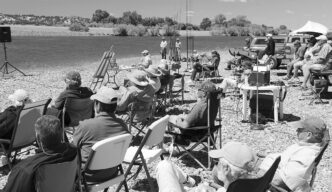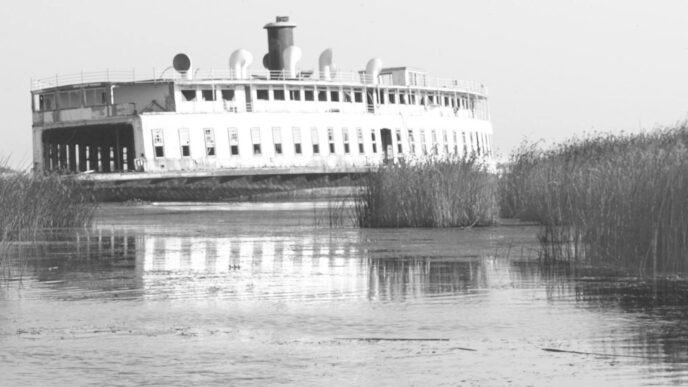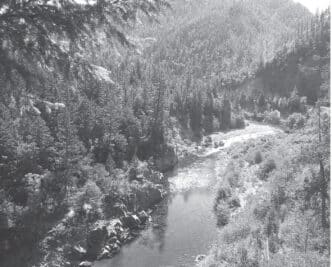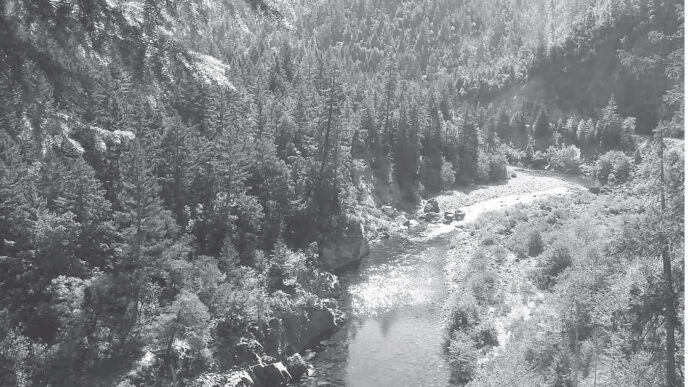“The Good Fight” entails more than simply protecting our fisheries. It also involves advancing the sport of angling and, in particular, fly fishing. Intriguingly, unlike participants in other forms of angling, fly fishers have long been active in creating fly-fishing clubs in their towns and cities. This is the story of one such club that serves the area around Redding.
For many of us, fly-fishing clubs are places to meet fellow anglers, learn the intricacies of fly fishing and fly tying, participate in outings, and carry out activities and projects that advance the sport. These clubs help form the larger fly-fishing community across the state (California has about 75 such clubs), in addition to uniting fly fishers in their home region.
The Shasta Trinity Fly Fishers (STFF) is about as good a fly-fishing club as there is in California these days, a distinction bolstered by being honored with the prestigious McKenzie Cup Award in 2012 “for the club that has made the most outstanding contribution to the Federation of Fly Fishers” and that best fulfills the objectives of the Federation: advancing the art, science, and sport as a way of fishing most consistent with the preservation and use of game fish resources; serving as a political voice for organized fly fishing; promoting conservation of recreational resources; facilitating and improving the knowledge of fly fishing and elevating the standard of integrity, honor, and courtesy of anglers; promoting the spirit of fellowship among anglers everywhere; establishing and maintaining liaisons with other organizations of anglers and conservationists and government agencies concerned with the sport of angling; and keeping its members informed of developments of interest to them. That’s a list of goals that any fly-fishing organization can be proud to achieve.
When I first came to Shasta County 18 years ago, it took me awhile to learn that such an aggregation of fly fishers existed here. Up to that point, the main social contacts that my wife and I had were with a newcomers group. When I finally joined the Shasta Fly Fishers, as the club was then called, I felt for the first time as if I had colleagues in the North State.
The club originally formed in Redding in the late 1970s. Blessed with an abundance of trout-rich waters nearby, including the Sacramento River running right through town, fly fishers naturally got together and organized a fly-fishing club. From the outset, the Shasta Fly Fishers was a highly active club, championing fly fishing and fisheries conservation.
Many of the reasons why the FFF awarded the McKenzie Cup to the STFF can be traced back to the efforts of the original founders and the small cadre of dedicated individuals who kept it going. What they accomplished across two decades is quite amazing, including starting fly-tying classes; stocking the local library with fly-fishing books and films; carrying out rehabilitation projects on the upper and lower Sacramento, Lake McCumber, and other waters; collecting the contents of fish stomachs for the Department of Fish and Game; hosting the 1988 Northern California Federation of Fly Fishers annual conclave; instigating new fishing regulations on the lower Sac; participating in the Reel Recovery Program, a fly-fishing program for cancer victims; clearing invasive species and planting and maintaining oaks and other trees, carrying water, one bucket at a time, at East Turtle Bay (East Turtle Bay is now one of Redding’s most accessible and user-friendly places along the river); and producing an award-winning series of 26 episodes about fly tying and fishing for Redding community public-access TV.
By the time I got involved in the club in the mid to late 1990s, it was an enthusiastic group of about 60 to 80 members. But organizational structures were pretty loose. Only a few members were actively involved in leadership roles — a characteristic that is the bane of most volunteer organizations. Programs were often arranged only a week before a meeting. One person valiantly continued as president because no one else stepped forward. He also led most fishing outings.
However, leadership matters, and ensuing presidents kept improving management aspects with such basics as having a treasurer develop a formal budget, getting a person to organize yearly outings with a different leader for each one, scheduling programs and presenters well in advance, delegating more responsibilities, and other organizational strategies. New fly fishers moved in and brought renewed energy and vision.
The momentum continued to grow with each passing year. Leadership initiated new programs and brought new life to old ones. More members began getting involved, taking responsibility for events, activities, and projects. Past presidents stayed active, rather than fading away, as often can happen. Because nearby Trinity County was providing both members and fishing opportunities, mainly the popular Trinity River, the Shasta Fly Fishers changed its name to the Shasta Trinity Fly Fishers in 2005. By 2012, the club had close to 250 members. Today, about 65 members are actively contributing each year, including to many activities not mentioned here. This high level of participation reflects leadership at its best.
While all of this was going on, a second fly club got going in Shasta County — one principally for women, called the Shasta Mayflies. It had separate meetings, separate outings, more homemade baked goodies, and all the rest. But as the Shasta Trinity Fly Fishers kept growing, the Mayflies saw no reason to remain separate and joined STFF in 2011.
The Goings-On of a Fly Club
The glue that holds together a fly club is the monthly meeting — a social and business gathering, a time for sharing, and an opportunity to hear a fly-fishing program, usually about some river, lake, or region. According to the STFF’s Web site, “Our meetings include updates on what’s going on locally, fishing reports, and lies.
We offer a monthly raffle, along with presentations by prominent guides, fly fishers, and biologists.” The STFF’s programs cover not only California waters, but also ones in Montana, Oregon, Alaska, Russia, and the Southern Hemisphere — in short, anywhere one can cast a fly for fish. Each year, a photo contest is held at the December meeting, and members vote on photos they’ve taken that year and award prizes.
The second standard activity for most clubs is the fishing outing or “fishout.” A chairperson in the STFF now schedules all of the outings for the year and recruits “fishmasters” to organize and lead each outing. He typically provides instruction on how to fish that particular water, including the choice of flies, techniques, and so on. Local club outings typically take in the lower and upper Sacramento, the Trinity River, Baum Lake, Lewiston Lake, Manzanita Lake, Klamath Lake, Clear Creek, the Klamath River, and Eagle Lake, among many others, including private waters stocked with humongous fish. This isn’t an activity just for the accomplished anglers in the group. The STFF has some outstanding fly fishers willing to help any neophyte learn this sport.
Another major activity of the STFF is fly tying. Classes are organized each year for beginning, intermediate, and advanced fly tyers. Expert fly tyers are sometimes brought in to lead workshops. Tying demonstrations are usually included with club activities, for example, before meetings in conjunction with outings and special events. I am not a fly tyer (my home is cluttered enough already, without a room full of feathers), but such an abundance of fly-tying activities leads me to speculate that some STFF members spend more time tying flies than casting them.
Speaking of casting . . . this is another major focus for the club. Classes for beginners and experienced casters are scheduled each year, conducted by one or more master casters. A recent development has been the rise of Spey casting: using a longer rod and two hands to cast much farther. For the last couple of years, the STFF has organized the Spey Fest on the Sacramento River involving demonstrations and instruction by advanced casters. Close to 100 fly fishers typically attend, some from distant locales. STFF members organize and coordinate the event. Fly tying is part of it, too, as is good food.
For these and other activities, the support of a good fly shop is a great resource to have. The Fly Shop in Redding, possibly the most successful fly shop in the country, has been a prime supporter of the STFF, along with all other events related to fly fishing.
However, the reach of the Shasta Trinity Fly Fishers extends much further than these core activities — to youth programs, conservation programs, support programs that use fly fishing as therapy, broader community outreach programs that acquaint the public at large with the nature and appeal of fly fishing, and, to support all these, fundraising.
Youth Programs
Few agendas are more important for outdoor clubs than engaging young people in nature. If we are to have healthy waterways populated by native and wild trout far into the future, the next generations have to become stewards of such precious resources. This is especially critical in this technological age. The best way to produce a steward who values the natural world is to have that person engage with that world. The STFF has fully embraced this mission with a number of programs aimed at fostering a conservation ethic and greater understanding of the natural world among local youths.
One such program in cooperation with the California Department of Fish and Wildlife is the Trout in the Classroom Project. Under the tutelage of STFF members, students in local elementary schools raise trout from eggs to fry and then release them into approved coldwater streams and lakes to grow into adults. The STFF also provides all the funding for this program, including busing the students to where the fry are released.
Nothing beats catching fish, however. Every summer, the STFF, again in cooperation with the DFW, hosts fishing days for kids at ponds located near the Mt. Shasta Hatchery. The club funds this project, while members serve as fishing guides in assisting youngsters in fishing for sometimes very large fish. More than 900 boys and girls typically participate. We just hope that they won’t grow up thinking that hooking big trout is ever going to be this easy again.
A new STFF activity is supporting Cast Hope — a program designed to provide disadvantaged youths with a fly-fishing experience. Cast Hope is a nonprofit organization in Northern California that seeks to bring youths and adult mentors together through fly fishing. STFF members serve as fly-fishing mentors while fostering a young person’s positive relationship with an adult and a healthy, lifelong hobby.
The club also supports a five-day summer adventure for 10-to-15-year-old girls and boys at Fish Camp, which is conducted by The Fly Shop on its private ranch outside Weed. Each year, the STFF holds an essay contest for kids in Shasta, Siskiyou, Tehama, and Trinity Counties. Full scholarships are then awarded to six contest winners, covering accommodation, meals, and all fly-fishing equipment. Fish Camp includes lessons in entomology, fly casting, fly tying, and of course, hooking fish on a fly.
And then there is the Junior Fly Tying Program. Twice a year, STFF volunteers provide a seven-week fly-tying course for boys and girls ages 10 to 17. All equipment and materials are provided.
Conservation
Since its inception, the STFF has carried out conservation efforts. One recent project that began in 2004 and was completed in 2006 was an extensive multiagency undertaking on Salt Creek, a tributary to the Sacramento off of the popular River Trail. The objective was to provide passage for spawning trout and salmon through a culvert passing under Highway 299. The STFF provided $5,000 in materials and 150 hours of manpower to install a set of jump pools and ladder baffles in the culvert. These allowed the fish to migrate up Salt Creek and spawn in its higher reaches.
The club helped in a study to restore tens of miles of habitat in Battle Creek and its tributaries by removing a number of dams. This vital project eventually received funding and has been responsible for the expanded return of salmon and steelhead to this waterway.
Restoration of the Trinity River has been another club effort. The STFF contributed money and volunteer workers to restore native plants along this damaged river and was awarded a Take Pride in America certificate from the U.S. Department of Interior for its involvement in this project. The STFF has also established a $5,000 scholarship fund (the Shasta Trinity Fly Fishers Scholarship Fund) at Humboldt State University, in Arcata, to be awarded each year to an eligible recipient studying in the Department of Fisheries with an emphasis on freshwater fisheries. The club has regularly provided assistance to the Department of Fish and Wildlife, paying for and installing signs; repairing kiosks; gathering scales and other materials for fish identifications, such as for redband trout or steelhead; surveying and counting fish in stream sections in places such as Hat Creek; and giving financial support for selected projects. The STFF has also given money to many conservation organizations across many years.
Fly Fishing for Healing
In recent years, nationwide projects have been initiated to introduce individuals with infirmities to fly fishing. The STFF has been quick to participate. One is Project Healing Waters. It is dedicated to the physical and emotional rehabilitation of disabled military service personnel and veterans through fly-fishing outings, fly tying, rod building, entomology classes, and other clinics. The STFF provides all fly-fishing and fly-tying equipment, with members instructing and guiding on flyfishing outings. It takes these individuals out of their home or facility to a refreshing setting to experience this sport’s healing benefits. One report stated: “Everyone was so intent on fishing that we had a hard time getting them off the water for lunch.
I don’t know how many times we had to ring the dinner bell before getting everyone to come and eat.” Anyone who fishes should be able to identify with this experience of forgetting all else except the flowing water and absorbing challenge of trying to fool a trout with a fly. But for many participants, the socialization and camaraderie are just as important as the fishing. Another such program is Casting for Recovery. It provides an opportunity for women with breast cancer to spend a cost-free weekend in a natural setting and experience the therapeutic aspects of fly fishing. The Shasta Mayflies, now part of the STFF, has raised funds for this program, including sponsoring the Fly Fishing Tour’s films shown at Redding’s Cascade Theater in 2012 and again in 2013. Hundreds attended each year.
Community Outreach
The STFF is continually bringing the world of fly fishing to the public. One major undertaking was a 90-day exhibit at the Turtle Bay Museum, with financial support from The Fly Shop, entitled “Fly Fishing: The Art of Deception.” Besides helping organize the exhibit, STFF members contributed historical fly-fishing gear, some going back to the 1880s. One or more STFF members manned the exhibit at all times to answer questions, provide information, tie flies, and demonstrate methods. Part of the exhibit was the three-day Fly-Tying Expo, which featured fly tying demonstrations by expert tyers, as well as opportunities for visitors to try their hand at this craft. The combined exhibit and Fly Tying Expo was among the most popular programs ever at the Turtle Bay Museum.
Each year, the STFF holds its public Fly Fishing Fair in Redding’s Caldwell Park. It includes fly-casting and fly-tying demonstrations, with opportunities for visitors to practice both. There are displays of equipment, art, entomology, fishing locations, and more. A major attraction is the fly-fishing swap-and-sell display, featuring rods, reels, other fly-fishing gear, and accessories.
Fundraising
All these activities require financial support, in addition to the volunteer efforts of club members, and fundraising is a major club undertaking. For example, in April 2011, the STFF established its own clubhouse/classroom to use for board meetings, special presentations, fly-tying and rod-building classes, entomology instruction, pre-trip meetings, photography classes, knot-tying lessons, and other activities. The facility is equipped with video projection equipment (for both live and taped presentations), fly-tying vises and related tools, an inventory of fly-tying materials, hooks, and an expansive lending library of fly-fishing books, tapes, and DVDs.
But rather than continuing to rent this facility, the club has embarked on a project to build its own clubhouse. It has secured the approval from the City of Redding for a location on city property in a public park. With volunteers to design and oversee its construction, the STFF is now launching an ambitious fundraising effort.
Beyond this clubhouse project, much of the funding for the STFF comes from an annual dinner that keeps growing larger and larger. Ongoing raffles at monthly meetings also contribute. This is the same as with most other clubs. What makes the STFF different, perhaps, is its scope and amount of funds raised.
It takes a lot to make a fly-fishing club successful: good leadership, active members, activities that are fun and that engage everyone, from neophytes to accomplished anglers, and activities and programs that place the club in the larger flyfishing community and the community in which its members live and participate. It takes time, and it takes money, but the rewards of investing both in a successful club are great, both for its members and for the sport itself.















